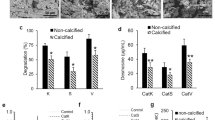Abstract
Elastin was isolated from human aortic tissues by extraction with formic acid. The aortas came from individuals of both sexes with ages ranging from 18 to 67 years. The elastin was treated to remove pre-existing nuclei for hydroxyapatite and mineralizedin vitro by incubation in a solution metastable to hydroxyapatite. The results showed an increased rate of mineralizationin vitro as the age of the individual from whom the aorta was obtained increased. The lag period in mineral formation seen with elastin samples obtained from individuals below the age 40, disappeared with older elastin. Amino-acid analysis of the elastin samples confirmed earlier results by indicating an increase in the more polar amino acids in the older elastin samples. Exposure of the extracted elastin samples to several proteolytic enzymes including elastase confirmed the identity of the material as elastin.
Similar content being viewed by others
References
Ayer, J.P., Hass, G.M., Philpott, D.E.: Aortic elastic tissue: Isolation with use of formic acid and discussion of some of its properties. Arch. Path.65, 519–544 (1958)
Blankenhorn, D.H.: Calcium deposits in the plaque. In: Evolution of the atherosclerotic plaque (Jones, R.J. ed.). Chicago: University of Chicago Press 1963
Blumenthal, H.T., Lansing, A.I., Gray, S.H.: The Interrelation of elastic tissue and calcium in the genesis of arteriosclerosis. Amer. J. Path.26, 989 (1950)
Eilberg, R.G., Mori, K.: Early stages ofin vitro calcification of human aortic tissue. Nature (Lond.)223, 518–520 (1969)
Eisenstein, R., Ayer, J.P., Papjiannis, S., Hass, G.M., Ellis, H.: Mineral binding by human arterial elastic tissue. Lab. Invest.13, 1198–1204 (1964)
Franzblau, C., Faris, B., Papaioannou, P.L.: Lysinonorleucine. A new amino acid from hydrolysates of elastin. Biochemistry (Wash.)8, 2833–2837 (1969)
Lansing, A.I., Roberts, E., Ramasarma, G.B., Rosenthal, T.B., Alex, M.: Changes with age in amino acid composition of arterial elastin. Proc. Soc. exp. Biol. (N. Y.)74, 714–717 (1951)
Sobel, A.E., Leibowitz, S., Eilberg, R.G., Lamy, F.: Nucleation by elastin. Nature (Lond.)211, 45 (1966)
Yu, S.Y., Blumenthal, H.T.: The calcification of elastic fibers. II Ultramicroscopic characteristics. J. Geront.18, 127 (1963)
Author information
Authors and Affiliations
Rights and permissions
About this article
Cite this article
Seligman, M., Eilberg, R.G. & Fishman, L. Mineralization of elastin extracted from human aortic tissues. Calc. Tis Res. 17, 229–234 (1975). https://doi.org/10.1007/BF02546686
Received:
Accepted:
Issue Date:
DOI: https://doi.org/10.1007/BF02546686




